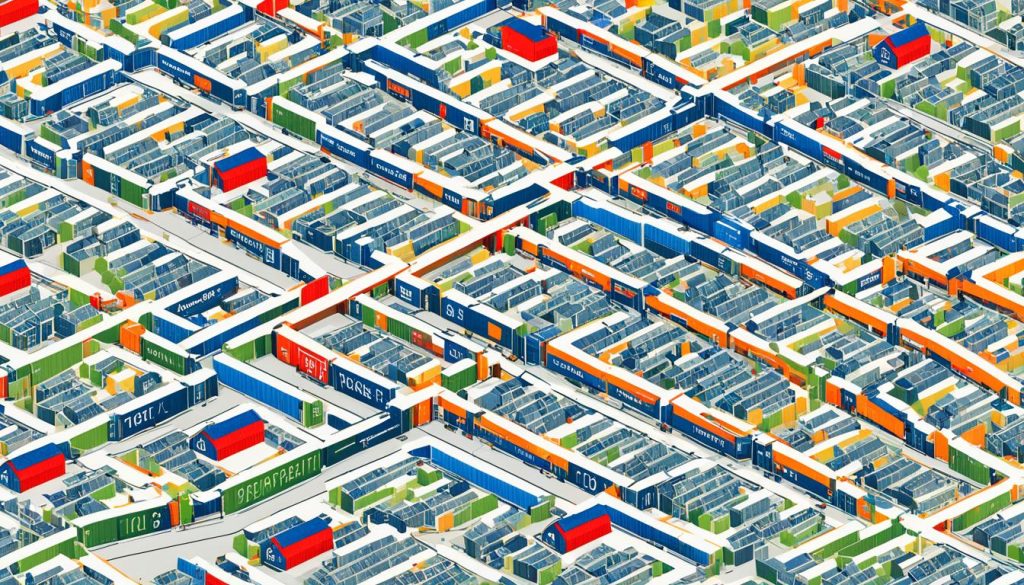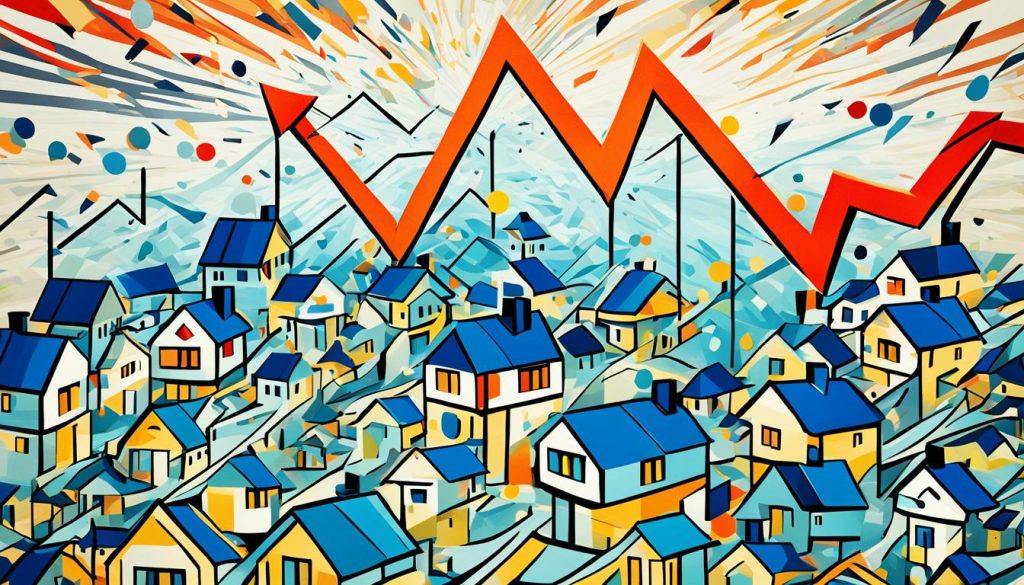Looking for a new home? The mortgage rate is a key factor to think about. It affects your monthly payments and the total cost of your loan. Knowing about mortgage rates, like the difference between fixed and adjustable rates, can help you save money1.
Many things can change mortgage rates, such as inflation, borrowing costs, and your credit score12. The Federal Reserve, housing market, and global events also play a role12.
Key Takeaways
- Mortgage rates are key in buying a home, affecting how much you pay to borrow money.
- Many things, like inflation and your credit score, can change mortgage rates.
- Knowing the difference between fixed and adjustable-rate mortgages helps you choose wisely.
- Comparing rates and APRs helps find the best loan for your budget.
- Improving your credit score and making a bigger down payment can get you a better rate.
What is a Mortgage Rate?
A mortgage rate is the interest a lender charges for a home loan. It’s shown as a percentage of the loan’s total amount3. This rate is key in figuring out your monthly payment, along with the loan size and term. There are fixed and adjustable rates, and knowing the difference helps pick the right loan for you.
Fixed-Rate Mortgages
Fixed-rate mortgages have the same interest rate for the loan’s whole term, usually 15 or 30 years. This means your monthly payment stays the same, making budgeting easier. Many homebuyers like fixed rates for their stability and predictability4.
Adjustable-Rate Mortgages (ARMs)
ARMs have an interest rate that changes over time, based on the market4. The rate is fixed at first, for 5 or 7 years, then changes every year or every half-year. This can be good if rates go down, but you could pay more if rates go up4.
It’s important to know the differences between fixed and adjustable-rate mortgages when picking a loan3. Lenders offer various options with different credit score and down payment requirements. So, it’s smart to compare offers to find the best one for you3.
Factors Affecting Mortgage Rates
Mortgage rates change due to many economic and personal factors. It’s key for borrowers to know these factors to get a better rate.
Economic Factors
The economy greatly affects mortgage rates. Things like the economy’s strength, inflation, jobs, and stock and bond markets play a part5. Rates change based on credit supply and demand. More demand means higher rates, less demand means lower rates5. The Federal Reserve’s policies also impact mortgage rates6.
Personal Financial Factors
Your financial details are important for mortgage rates too. Things like your credit score, debt compared to income, down payment, and loan size matter6. A high credit score and a 20% down payment can get you a better rate. Loans backed by the government, like VA, USDA, and FHA, offer options with little to no down payment6.
Both economic and personal factors mix to set your mortgage rate. Knowing these can help you make better choices and find better financing options.

“The right mortgage rate can make a big difference in your home’s long-term cost. Learning about the main factors that affect rates is key to getting the best deal.”
Comparing Mortgage Rates and APRs
When looking at mortgage options, it’s key to know the difference between the mortgage rate and the annual percentage rate (APR). The mortgage rate is the basic interest on the loan7. The APR adds extra fees like broker fees, discount points, and some closing costs8.
The APR shows the true loan cost8. It includes the interest and other charges7. By August 2020, the average U.S. mortgage rate for a 30-year fixed-rate mortgage was 2.91%7. The average APR for a 30-year fixed-rate home loan was 2.99%7.
The APR looks at interest, points, fees, and insurance7. It doesn’t include some closing costs like title fees and escrowed amounts7. So, when comparing loans, focus on the APR to see the full loan cost8.
Also, think about a 5-year cost analysis when comparing loans7. The APR might not matter if you won’t keep the loan for 5 years. A loan with a lower rate but higher fees could be cheaper over a few years7.

The APR shows the real cost of a mortgage8. It’s important to compare APRs to find the best deal for your budget9. Lenders must show the loan’s APR by law, making things clear for consumers7.
prime rate, APR, factors affecting mortgage rates
The prime rate, set by the Federal Reserve, is key to mortgage rates10. When the Federal Reserve changes the federal funds rate, it affects the prime rate. This, in turn, changes the interest rates on mortgages and loans10. Bond yields and inflation also play a role, as lenders adjust rates based on market conditions and lending risk.
The current prime rate in the U.S. is 8.5 percent10. In July 2023, the federal funds rate was between 5.25% and 5.50%10. Canada’s prime rate was 7.20% as of January 2024, and Japan’s was 1.48%10. The highest U.S. prime rate was 21.5% in December 198010.
The prime rate has been steady at 8.50% for a while10. It has changed over time, like in July 2023: 8.50%, May 2022: 4.00%, and March 2020: 3.25%10. Usually, the prime rate stays around 2% to 3% after World War II10. Changes in the prime rate affect loans like home equity loans, adjustable-rate mortgages, credit card balances, and small business loans.
The Annual Percentage Rate (APR) is key when looking at mortgage rates. U.S. credit card interest rates average about 20.66 percent11. During the COVID-19 pandemic, the Federal Reserve’s target interest rate was 0 percent to 0.25 percent11. Mortgage rates were lower, sometimes under 3 percent during the pandemic11. The prime rate is usually three points above the federal funds rate11.
Interest rates depend on credit scores, with better scores getting lower rates11. Scores under 620 are considered “subprime,” leading to higher rates11. Fixed-rate mortgages or loans have constant interest rates, while banks can change credit card APR without telling you11.
In summary, the prime rate, set by the Federal Reserve, greatly affects mortgage rates. Other factors like bond yields and inflation also play a role. Knowing these can help you make better choices for your home financing.
Strategies for Getting the Best Mortgage Rate
Getting the best mortgage rate is crucial for homebuyers. There are ways to improve your financing and save thousands over your loan’s life. By using these strategies, you can get a better deal.
Improving Your Credit Score
Your credit score is key when lenders set your mortgage rate. You need a score of 620 or higher for a conventional mortgage12. Scores above 740 get you the best rates12. Improve your score by paying down debt and fixing any credit report errors. This can lead to better loan terms.
Making a Larger Down Payment
A bigger down payment can lower your mortgage rate. Saving 20 percent can avoid PMI costs, which are 0.46 to 1.50 percent of the loan annually12. A larger down payment also makes lenders less risky, which might get you a lower rate.
Discount points can also reduce your rate. Each point costs 1 percent of the loan and lowers the rate by 0.25 percent12. Make sure it’s worth it for your situation.
Shopping around for lenders is key to finding the best rate. Getting two quotes can save you about $600 a year13. Four quotes can save you $1,200 annually13. Look for discounts or special programs from lenders too.
| Mortgage Type | Average Rate |
|---|---|
| 30-Year Fixed | 7.62% |
| 5/1 ARM | 6.61% |
| 15-Year Fixed | 6.91% |
Use these strategies to get a competitive mortgage rate and save on your home loan13.
“A 6 percent rate on a $300,000, 30-year mortgage saves nearly $1,200 a year and almost $6,000 over five years.” – Freddie Mac study
Conclusion
Starting your journey to buy a home? Knowing about mortgage rates, home loans, and financial planning is key to success14. You’ll need to understand credit scores, down payments, and different loan types. This knowledge helps you navigate the complex world of mortgage rates and affects your home loan cost.
Knowing what affects mortgage rates like the economy and your finances helps you make smart choices15. It’s also important to know the difference between mortgage rates and APRs. This knowledge helps you pick a loan that fits your financial planning goals.
Getting the best mortgage rates might mean improving your credit score or making a bigger down payment14. It also means looking at points and lender credits carefully. By focusing on these steps, you increase your chances of getting a good home loan. This sets you up for a successful home buying journey.
Source Links
- The Most Important Factors That Affect Mortgage Rates
- What Factors Determine And Move Mortgage Rates? | Bankrate
- How the Federal Reserve Affects Mortgage Rates – NerdWallet
- How The Fed’s Rate Decisions Move Mortgage Rates | Bankrate
- What Are the Forces Behind Interest Rates and What Causes Them to Rise?
- How does the Fed affect mortgage interest rates?
- APR Vs. Interest Rate: What’s The Difference?
- APR vs. Interest Rate: What’s the Difference?
- Interest Rate vs. APR: What’s the Difference?
- Prime Rate: Definition and How It Works
- How Does the Prime Interest Rate Affect You? | Bankrate
- How To Get The Best Mortgage Rate | Bankrate
- How to Get the Lowest Mortgage Rate
- Seven factors that determine your mortgage interest rate | Consumer Financial Protection Bureau
- How Interest Rates Affect the Housing Market

